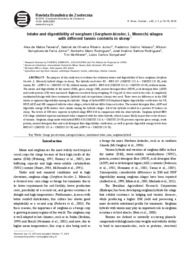Intake and digestibility of sorghum (Sorghum bicolor, L. Moench) silages with different tannin contents in sheep.
Intake and digestibility of sorghum (Sorghum bicolor, L. Moench) silages with different tannin contents in sheep.
Author(s): TEIXEIRA, A. de M.; RIBEIRO JÚNIOR, G. de O.; VELASCO, F. O.; FARIA JÚNIOR, W. G. de; RODRIGUEZ, N. M.; RODRIGUES, J. A. S.; McALLISTER, T.; GONÇALVES, L. C.
Summary: The purpose of this study was to evaluate the voluntary intake and digestibility of three sorghum (Sorghum bicolor, L. Moench) hybrid silages in sheep. The hybrids used were H1 - BRS 655 (CMSXS 222 A × CMSXS 235 R), with tannin; H2 - (ATF54 A × CMSXS 235 R), without tannin; and H3 - BRS 610 (CMSXS 232 A × CMSXS 234 R), without tannin. The intake and digestibility of dry matter (DM), gross energy (GE), neutral detergent fiber (NDF), acid detergent fiber (ADF) and crude protein (CP) were measured. Eighteen crossbred sheep weighing 59.4 kg (±8.3) were used in the trial. A completely randomized design with three treatments (hybrids) and six repetitions (sheep) was used. There were no differences in the DM intake or apparent digestibility among the hybrids. Silage of hybrid BRS 610 displayed higher digestibility coefficients for CP, NDF, ADF, and GE compared with the other silages, which did not differ from each other. The neutral detergent fiber, ADF and digestible energy (DE) intakes were similar among the hybrids silages. All of the hybrids resulted in a positive N balance in sheep. The levels of DE were superior in hybrid silage BRS 610 in comparison with the other hybrids. Sorghum hybrid BRS 610 silage exhibited superior nutritional value compared with the other hybrids, which is most likely in part due to the absence of tannins. Sorghum silage made with hybrid BRS 610 (CMSXS 232 A × CMSXS 234 R) presents superior gross energy, crude protein, neutral detergent fiber and acid detergent fiber digestibility coefficients, as well as greater digestible energy levels than BRS 655 (CMSXS 222 A × CMSXS 235 R) and (ATF54 A × CMSXS 235 R).
Publication year: 2014
Types of publication: Journal article
Unit: Embrapa Maize & Sorghum
Keywords: Balanço de nitrogênio, Forragem, Nutritive value, Silage, Sorgo, Tanino, Valor nutricional
Observation
Some of Embrapa's publications are published as ePub files. To read them, use or download one of the following free software options to your computer or mobile device. Android: Google Play Books; IOS: iBooks; Windows and Linux: Calibre.
Access other publications
Access the Agricultural Research Database (BDPA) to consult Embrapa's full library collection and records.
Visit Embrapa Bookstore to purchase books and other publications sold by Embrapa.

